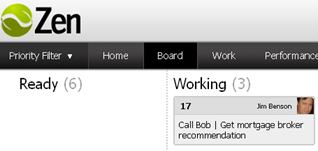Every Task is Sacred
One of the primary goals of a kanban is to make value explicit. When you spend your time doing something, the reward should be observable. Even if the task is vegging out, the reward is relaxation. You should engage in no task that is valueless. When a task does not provide value, it is considered waste.
Kanban has two main states: a "station,” where value is created, and a “transition,” where the work item is moved from one station to the next. In the kanban below, we see the flow of work for my upcoming book, Instant Karma: 10 Principles of Social Media for Business. In the pre-writing phase, I am creating the initial text for a chapter. When that’s done, and my editor is ready to look at it, she pulls a completed section from my pre-writing section and places it in her “focus” state. There she and I edit and re-edit that chapter until we think it is ready to send off to the crowdsourcers. I was creating value in the pre-writing state, when that value was realized it then went on to the next state of focus, where it remains until that value is realized.
In the kanban above we see that what is moving is not tasks – but the actual chapter. In a work-flow kanban tasks are the mechanics that create value, not the value itself. The value is explicit in the work-flow. Thus, in a kanban, the work-flow is also called a value-stream.
Here we have a task based kanban where I have the task of “Call Bob.” It’s going to run through my simplistic Backlog | Doing | Done kanban. But, let’s think about this a bit. Regardless of my feelings for Bob, does calling Bob ever give me actual value? No. "Call Bob" is merely a task, a mechanical action that should create value.
Later, if I am going over completed tasks and trying to figure out what makes me successful and what does not, “Call Bob” is a lousy artifact for judgment. There simply isn’t enough information there to let me make a decision.
So why not make the value explicit?
Here my reason for calling Bob is made more explicit.It could be anything you want from “talk about football” to “catch up.” Remember: Kanban isn’t making value judgments of your actions, it's simply reporting the value of what you accomplished. If you really like Bob, and want to call him just to shoot the breeze, that’s value to you. It’s fine. What you want is to discover tasks that don’t provide value and eliminate them, so you have more time to do what makes your life better.
Images created in Agile Zen, which I am loving.






